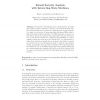351 search results - page 29 / 71 » Applying Morphology Generation Models to Machine Translation |
IADIS
2008
13 years 11 months ago
2008
Using open e-learning platforms as a tool to support the learning process has become an international tendency. Specially, in order to motivate the achievement of desired competen...
EMNLP
2010
13 years 8 months ago
2010
In this paper, we present a novel approach to enhance hierarchical phrase-based machine translation systems with linguistically motivated syntactic features. Rather than directly ...
SPIN
2004
Springer
14 years 3 months ago
2004
Springer
Nowadays, many distributed applications take advantage of the transparent distributed object systems provided by CORBA middlewares. While greatly reduce the design and coding effo...
ANLP
1997
13 years 11 months ago
1997
We classify and review current approaches to software infrastructure for research, development and delivery of NLP systems. The task is motivated by a discussion of current trends...
ESORICS
2002
Springer
14 years 9 months ago
2002
Springer
We introduce the ISM approach, a framework for modeling and verifying reactive systems in a formal, even machine-checked, way. The framework has been developed for applications in ...

